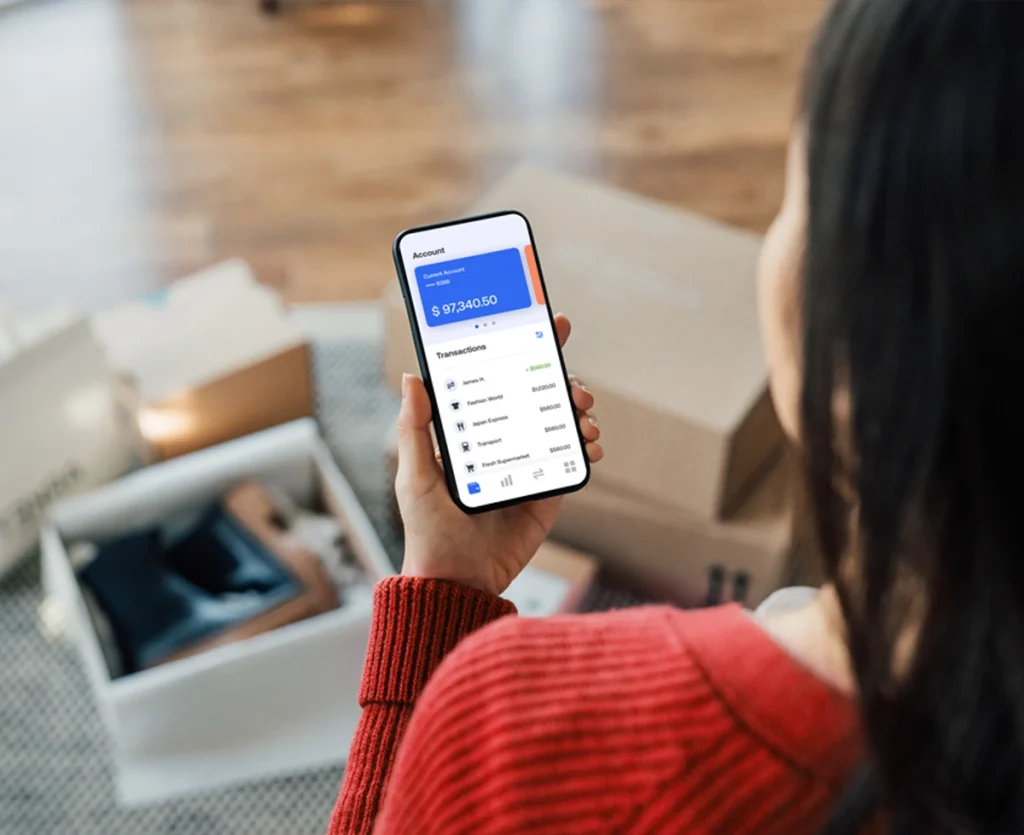Types of MVP in software development
Different MVPs will bring different results and should be used in certain situations. By understanding the business model and defining your requirements, you can determine which type of MVP is best for your company:
- Concierge: You will manually assist your user in achieving their goals to validate whether they need what you are offering and to test the market demand before developing the applications.
- The Wizard of Oz: This MVP in software development is the same as concierge. The difference is users/customers don’t know that the idea is being tested.
- Landing pages: This allows you to test the product idea and decide whether to build an initial version of the minimum viable product or a different version than the intended version. It allows interested users to join a mailing list or click to buy now.
- Email MVP: Creating an email will help you achieve your customers’ tendencies. The action of having read the email but not clicking on the call-to-action buttons can be concluded that the offered value proposition is not appealing.
- Single-feature MVP: It is used to test and validate the demand for independent features in a product. It comes in handy when entrepreneurs want to introduce new features or test the dependability of third-party integrations.
- First man: It contains only the essential functions and will be used by early adopters. Typically, the product is aimed at such customers, who are more tolerant, more willing to provide feedback, and have a greater ability to understand the product vision with only a prototype or basic product information, in addition to helping to fill gaps in the desired functionality.
- Crowdfunding: You can explore the final products’ market position through participants contributions on these public funding platforms. The essence of this type is that crowdfunding platforms allow donations to be made even before the product is released.
- Software prototypes: A program or application performs one or two functions required to test the viability of your primary functions. This allows you to narrow the target group, gather feedback and analysis, and concentrate on testing.
- Piecemeal: With this MVP software development example, you will leverage existing services and platforms to test your idea and do some research, before developing the product. This is best for business with tight market
Now that you have understood the differences between each type of MVP, here are the top software MVP examples from top brands.
Successful MVP in software development examples
E-commerce & marketplace MVPs
Amazon: From MVP bookstore to e-commerce empire
MVP type: Concierge + Landing page
Year: 1994
Initial investment: ~$10,000
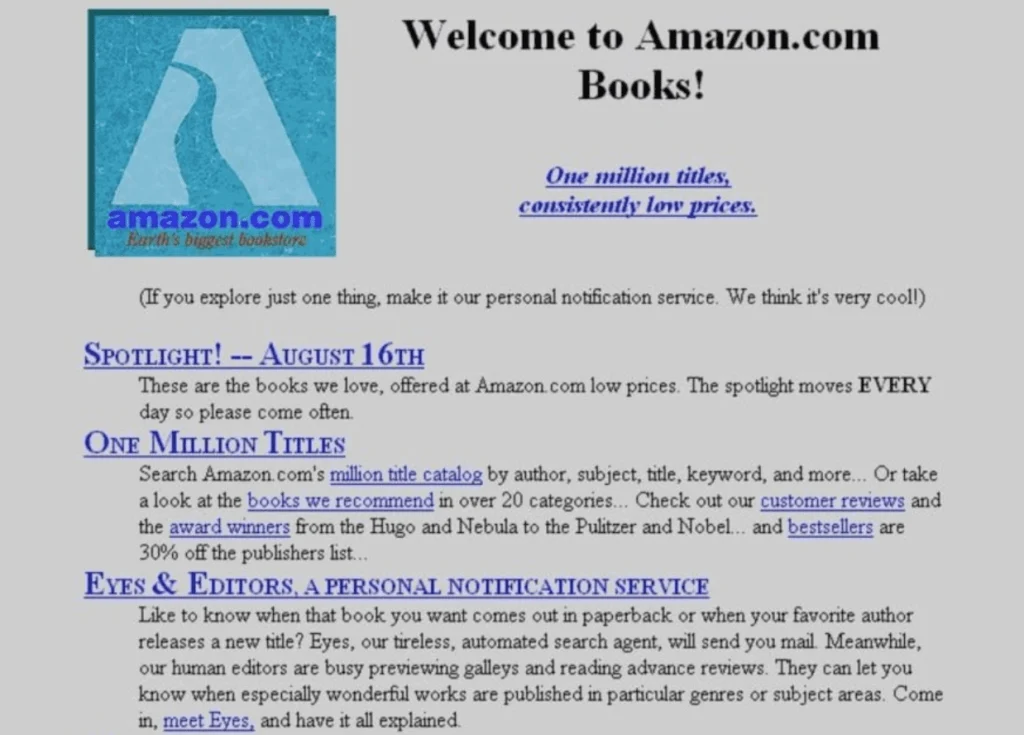
Background & Problem
In 1994, Jeff Bezos noticed internet usage was growing at 2,300% annually and identified an opportunity to test e-commerce viability. However, building inventory infrastructure, warehouses, and logistics would require millions in capital before knowing if anyone would actually buy products online.
MVP strategy
Bezos created a simple website listing books with a clear value proposition: “Earth’s Biggest Bookstore.” When customers ordered, he manually:
- Purchased books from distributors
- Packaged them at home
- Drove to the post office for shipping
- Handled all customer service personally
This concierge approach tested the critical hypothesis: “Will people buy products online without seeing them first?” The landing page collected orders while Bezos fulfilled them manually to validate demand without upfront inventory risk.
Execution details
- Timeline: Launched in 2 months
- Budget: Under $10,000 for website development
- Team: Jeff + 2 friends operating from a garage
- Key metrics tracked: Orders per day, customer return rate, average order value
Results & Learning
- Week 1: Sales to all 50 US states and 45 countries
- Month 1: $20,000 in book sales
- Year 1: $511,000 in revenue
The MVP proved online commerce had massive potential. Customer feedback revealed people wanted faster shipping and more product categories. Amazon gradually automated fulfillment, expanded to music/DVDs, then “everything,” becoming the $1.7 trillion company we know today.
Start with manual processes to validate demand before building automation. Amazon’s concierge MVP proved e-commerce demand existed before investing millions in warehouses and logistics infrastructure.
Relevant for: E-commerce startups, marketplace platforms, inventory-based businesses, retail tech
2. Etsy: Crafting a marketplace MVP
MVP type: Single feature
Year: 2005
Initial investment: ~$30,000
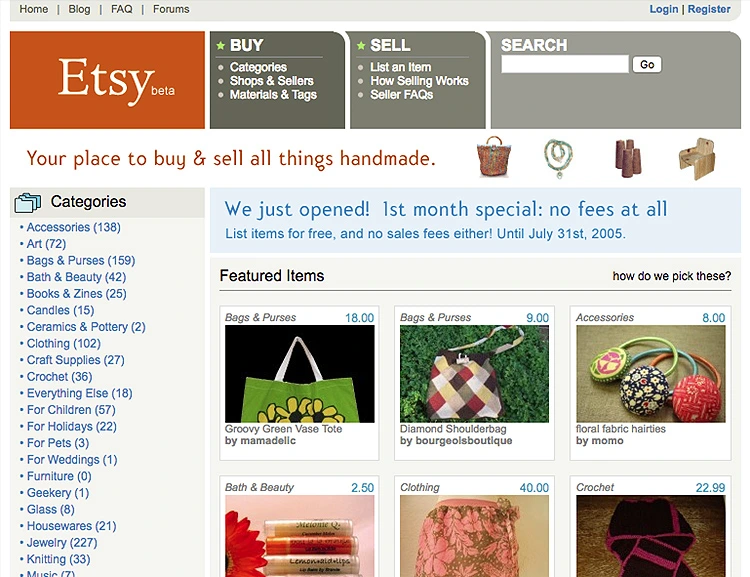
Background & Problem
Robert Kalin and his co-founders saw that eBay’s marketplace was cluttered, slow, and didn’t serve crafters well. Artisans needed a dedicated platform that understood their specific needs and could provide fast, reliable transactions.
MVP strategy
Etsy launched with one core feature: a simple marketplace where crafters could list handmade items and buyers could purchase them. Unlike competitors, they focused on:
- Clean, fast-loading pages
- Maker-focused design aesthetic
- Quick transaction processing
- Community-first approach
The MVP validated whether there was demand for a craft-specific marketplace that valued speed and simplicity over feature bloat.
Execution details
- Timeline: 3 months from idea to launch
- Budget: $30,000 seed funding
- Team: 3 founders + 2 developers
- Initial features: Product listings, search, checkout, seller profiles
Results & Learning
- First month: 300 sellers listed products
- 6 months: 10,000 active sellers
- Current: 7.5M active sellers, $13.5B in annual sales
Etsy learned that their target audience valued community and shared values over just transactional efficiency. They added forums, seller resources, and showcased maker stories – features inspired by early user feedback.
Learn from competitors’ mistakes. Etsy identified eBay’s slow performance as a pain point and made speed their MVP’s differentiator, winning over frustrated artisans.
Relevant for: Marketplace platforms, niche e-commerce, community-driven businesses, creator economy
3. Groupon: WordPress blog to billion-dollar business
MVP type: Piecemeal
Year: 2008
Initial investment: <$5,000
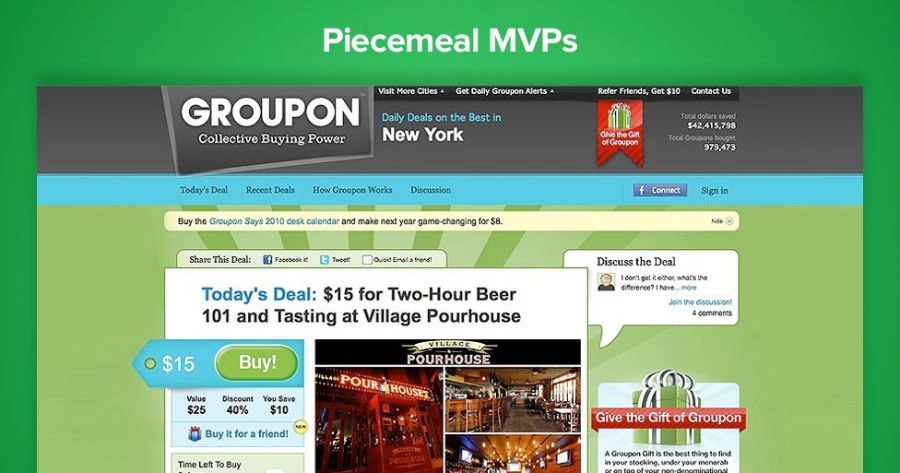
Background & Problem
Andrew Mason wanted to test if people would buy local deals online, but building a custom marketplace platform would take months and tens of thousands of dollars. He needed to validate the concept first.
MVP strategy
Mason launched an incredibly simple MVP using existing tools:
- WordPress blog for posting daily deals
- Manually emailed PDF vouchers to buyers
- Called merchants to arrange deals personally
- Used PayPal for payment processing
This piecemeal approach leveraged proven platforms to test the business model: Would people pre-purchase deals for local businesses?
Execution details
- Timeline: Launched in 2 weeks
- Budget: Under $5,000 (domain, hosting, time)
- Team: Just Mason initially
- First deal: 50% off pizza at a restaurant in Groupon’s building
Results & Learning
- First deal: 20 people bought (validation!)
- 6 months: Expanded to multiple cities
- 18 months: $33M in revenue
- 2 years: Raised $1B+ in funding
The MVP proved the group buying model worked. User feedback revealed people wanted mobile access, automatic vouchers, and more deal categories. Groupon built custom infrastructure only after validating the core business model.
Don’t build what you can borrow. Groupon validated a billion-dollar business model using WordPress and email before investing in custom development.
Relevant for: Marketplace startups, local business platforms, bootstrap entrepreneurs, budget-constrained founders
4. Zappos: Testing e-commerce without inventory
MVP type: Wizard of Oz
Year: 1999
Initial investment: Minimal
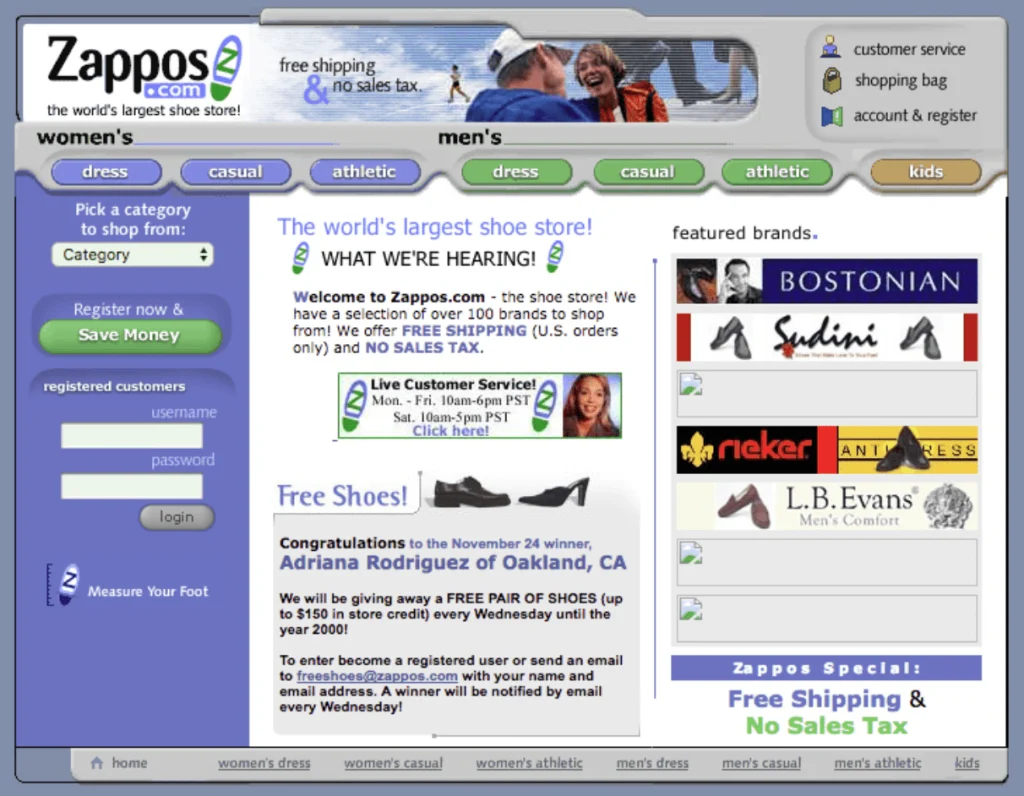
Background & Problem
Nick Swinmurn believed people would buy shoes online, but everyone told him it wouldn’t work, shoes need to be tried on. Building inventory would require hundreds of thousands in capital, which he’d lose if the hypothesis was wrong.
MVP strategy
Swinmurn created “Shoesite.com” with a clever Wizard of Oz approach:
- Photographed shoes at local shoe stores
- Listed photos on his website
- When someone ordered, he bought the shoes at retail
- Shipped them to the customer
To customers, it appeared to be a fully functional online shoe store. Behind the scenes, it was entirely manual. This approach tested whether people would buy shoes online without Swinmurn risking capital on inventory.
Execution details
- Timeline: First sales within weeks
- Budget: Minimal (just website hosting + time)
- Team: Nick alone initially
- Margin: Negative initially (bought retail, sold retail)
Results & Learning
- Early traction: Consistent daily orders
- Key insight: People WOULD buy shoes online
- Validation: Customer complaints were about selection, not the concept
- Outcome: Renamed to Zappos, raised capital, built inventory
Once validated, Zappos invested in inventory, warehousing, and became legendary for customer service. Amazon acquired them for $1.2 billion in 2009.
Test demand before investing in infrastructure. Zappos proved people would buy shoes online using a manual process, then built the logistics infrastructure with confidence.
Relevant for: E-commerce startups, inventory businesses, marketplace platforms, retail innovation
Social media & community MVPs
5. Facebook: From Harvard-only network to global platform
MVP type: Single feature + First man
Year: 2004
Initial investment: Minimal
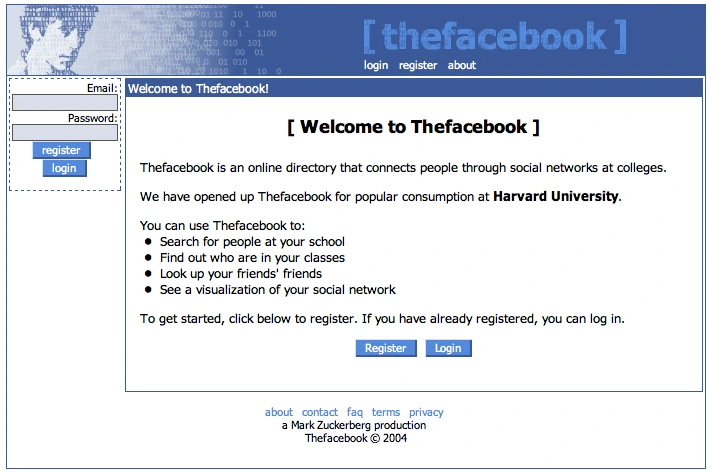
Background & Problem
Mark Zuckerberg observed that Harvard didn’t have an online student directory with photos. Students wanted a way to connect with classmates and see who was in their courses. Existing platforms like Friendster were bloated with features students didn’t want.
MVP strategy
Zuckerberg built “Thefacebook” with just two core features:
- Profile pages: Name, photo, courses, interests
- Wall posting: Leave messages on friends’ pages
That’s it. No news feed, no photos, no events, no messaging, no likes. Just the minimum needed for students to connect. The first-man approach meant releasing exclusively to Harvard students, early adopters who would forgive imperfections.
Execution details
- Timeline: Built in one week
- Budget: Zero (Zuckerberg coded it himself)
- Team: Just Zuckerberg initially
- Initial features: Profiles + wall posts
Results & Learning
- First 24 hours: 1,200 students signed up (half of Harvard undergrads)
- First month: Spread to other Ivy League schools
- 6 months: 1 million users across 800+ college networks
- Current: 3 billion monthly active users
Facebook learned that simplicity drove adoption. When they tried adding features too quickly, engagement dropped. The MVP’s constraint – Harvard only – created exclusivity and demand. They systematically expanded to other schools based on user requests.
Exclusivity creates demand. Facebook’s first-man MVP strategy of launching at Harvard only made the product more desirable when it expanded to other schools.
Relevant for: Social platforms, community apps, network effects businesses, college-focused products
6. Twitter: From failed podcast platform to social media giant
MVP type: First man (Internal tool)
Year: 2006
Initial Investment: Minimal
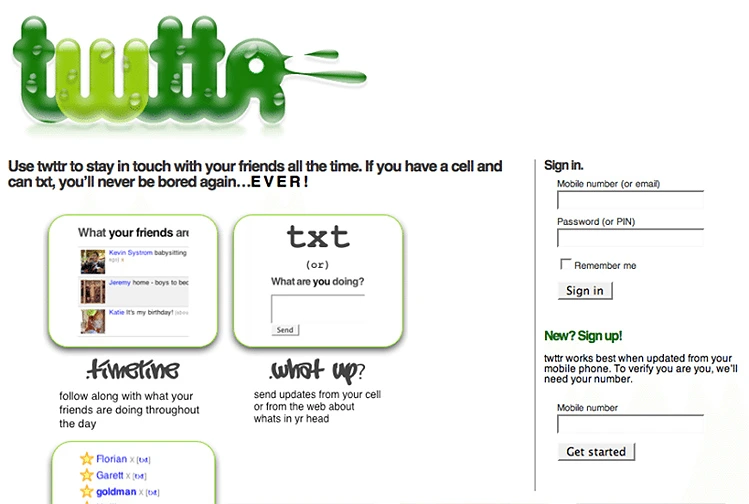
Background & Problem
Odeo, a podcasting platform, was struggling after Apple launched iTunes podcasting. During a hackathon to explore new ideas, Jack Dorsey proposed an SMS-based messaging service where people could share short status updates with groups of friends.
MVP strategy
The team built “twttr” as an internal tool for Odeo employees:
- Send 140-character messages via SMS (SMS limit: 160 chars)
- Messages distributed to followers automatically
- Simple web interface to view messages
- No images, no @mentions, no hashtags, just text
Odeo employees became the first users, testing whether short-form public updates had appeal beyond just messaging friends directly.
Execution details
- Timeline: Built in 2 weeks during hackathon
- Budget: Minimal (internal project)
- Team: Small group of Odeo employees
- Initial use case: Status updates during San Francisco earthquake
Results & Learning
- First insight: Employees spent hundreds on SMS using it
- Validation: During SF earthquake, Twitter provided real-time updates faster than news
- Pivot: Odeo shut down, founders focused 100% on Twitter
- Current: 450M+ monthly active users
Twitter learned that brevity and real-time updates were the magic combination. Early users requested @mentions and hashtags – features that became Twitter’s signature elements. The constraint of 140 characters (from SMS limits) became a defining feature.
Build for yourself first. Twitter succeeded because Odeo employees genuinely needed a way to share quick updates, making it an authentic solution to a real problem.
Relevant for: Social platforms, real-time communication tools, employee-first products, crisis communication
7. Instagram: One feature, billions of users
MVP type: Single feature
Year: 2010
Initial investment: Minimal
Background & Problem
Kevin Systrom and Mike Krieger observed that phone cameras were improving but photos still looked amateur compared to professional photography. They wanted to make anyone’s photos look beautiful and shareable.
MVP strategy
Instagram launched with an incredibly simple single-feature MVP:
- Take/upload a photo
- Apply one of several filters
- Share to a feed
That was the entire app. No Stories, no DMs, no Reels, no shopping, no ads. Just beautiful photos shared simply. The MVP tested: “Will people share more photos if we make them look better?”
Execution details
- Timeline: 8 weeks to build
- Budget: Bootstrapped initially
- Team: 2 founders
- Platform: iPhone only (iOS exclusive)
Results & Learning
- Launch day: 25,000 users signed up
- First week: 100,000 users
- 3 months: 1 million users
- 18 months: Acquired by Facebook for $1 billion
Instagram learned that filters weren’t just novelty, they solved a real problem of making amateur photos look professional. Users requested Android support, tagging, and explore features. Each addition came after validating the previous layer.
One feature done exceptionally well beats ten features done poorly. Instagram’s laser focus on photo filtering and sharing created a product that resonated immediately.
Relevant for: Photo apps, social platforms, creative tools, mobile-first products
8. Foursquare: Gamifying location check-ins
MVP type: Single feature
Year: 2009
Initial investment: ~$1.35M (seed round)
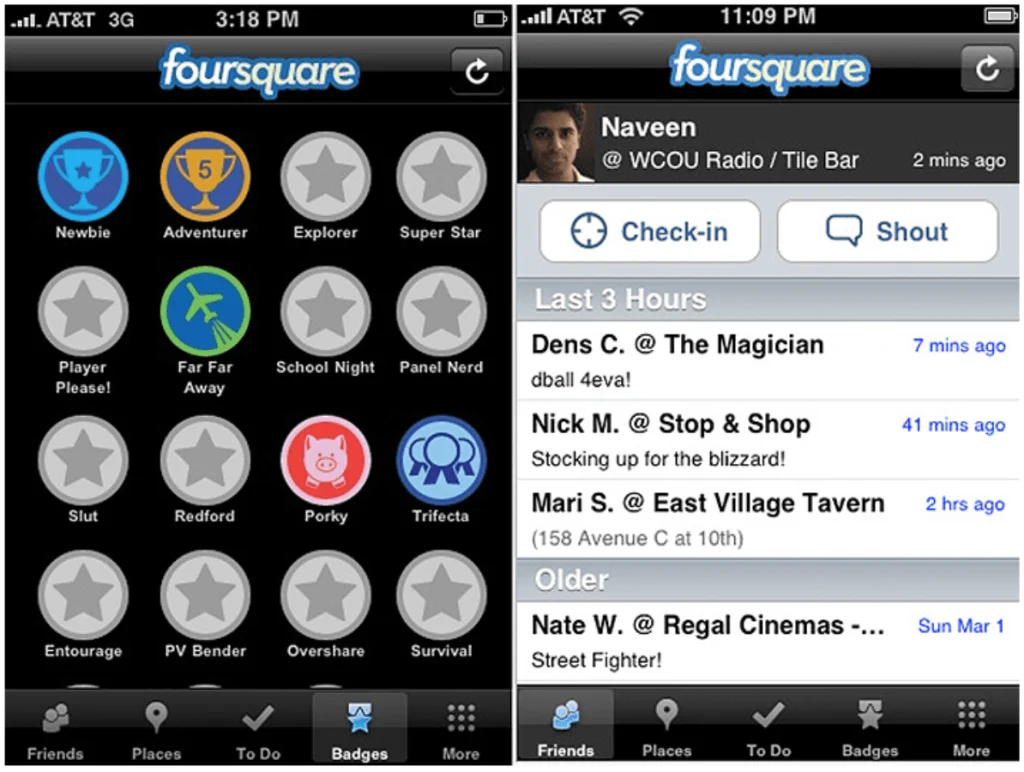
Background & Problem
Dennis Crowley and Naveen Selvadurai wanted to help people discover new places and connect with friends based on location. But location services were new, and user behavior around sharing location was uncertain.
MVP strategy
Foursquare launched with one core feature: check-ins. Users could check in at physical locations and see where friends were. That’s it initially.
- Simple check-in button
- Location-based friend list
- Basic venue database
- No recommendations, no reviews, no city guides
The MVP tested: “Will people voluntarily share their location to connect with friends?”
Execution details
- Timeline: 3-4 months to launch
- Budget: $1.35M seed funding
- Team: 2 founders + small development team
- Launch strategy: SXSW festival for initial traction
Results & Learning
- SXSW 2009: Went viral at the conference
- First year: 1 million users
- Key insight: Users checked in compulsively when gamification added (badges, mayorships)
After validating the check-in behavior, Foursquare added badges based on check-in patterns (become “mayor” of a venue by checking in most). This gamification drove explosive growth. Later, they added recommendations and evolved into a city guide platform.
Validate core behavior first, then add engagement layers. Foursquare confirmed people would check in before adding gamification that made it addictive.
Relevant for: Location-based apps, social discovery, gamification, local business platforms
9. ProductHunt: Community built on existing tools
MVP type: Piecemeal
Year: 2013
Initial investment: Minimal
Background & Problem
Ryan Hoover wanted to create a community where makers could share new products and get feedback. But building a full web platform would take months, and he wasn’t sure if the community would engage.
MVP strategy
Hoover used existing tools to create a piecemeal MVP:
- Linkydink: Email-based link sharing tool
- Personal network: Invited startup friends manually
- Twitter/social media: Promoted the idea
- Time investment: 20 minutes to set up
This validated whether people wanted a product discovery community before writing any code.
Execution details
- Timeline: 20 minutes to launch
- Budget: $0
- Team: Just Ryan initially
- Platform: Email-based link sharing
Results & Learning
- First 2 weeks: 170+ members joined
- Validation: Daily engagement, people sharing products actively
- Signal: Needed custom platform to scale
- Outcome: Built proper web platform after validation
Once Hoover validated the concept, he built a custom web platform. ProductHunt is now the #1 place for discovering new products, with millions of users and acquired by AngelList.
Validate communities before building platforms. ProductHunt proved people wanted a product discovery community using just email, then built infrastructure to scale.
Relevant for: Community platforms, content curation, startup tools, maker communities
SaaS & Productivity MVPs
10. Dropbox: Video MVP that sold the vision
MVP type: Email + Video + First man
Year: 2007
Initial investment: Minimal
Background & Problem
Drew Houston was frustrated by forgetting his USB drive and wanted to sync files across devices. Cloud storage existed but was clunky. Building the infrastructure seemed risky, would people trust the cloud with their files?
MVP strategy
Houston created a brilliant MVP without building the actual product first: a demo video. The 3-minute video showed exactly how Dropbox would work, including:
- Drag files into a folder
- Files automatically sync across devices
- Simple, magical experience
He posted it to Hacker News and tech forums, with a sign-up form to join the beta waitlist.
Execution details
- Timeline: 1 week to create video
- Budget: Minimal (just time to create screencast)
- Team: Drew Houston alone
- Distribution: Hacker News, tech blogs
- CTA: Email signup for beta access
Results & Learning
- Before video: 5,000 email signups
- After video: 75,000 email signups overnight
- Validation: Massive demand without building infrastructure
- Outcome: Raised $1.2M seed round, built actual product
The video demonstrated the product experience so effectively that people signed up in droves. Houston learned what features users asked about most in comments, shaping development priorities. Today, Dropbox has 700M+ users and $2B+ in annual revenue.
Show, don’t build. Dropbox validated massive demand with just a video, proving you can test product-market fit before writing production code.
Relevant for: Complex technical products, cloud services, developer tools, products requiring infrastructure investment
11. Buffer: Landing page that validated pricing
MVP type: Landing page
Year: 2010
Initial investment: ~$500
Background & Problem
Joel Gascoigne wanted to build a tool for scheduling social media posts, but wasn’t sure if people would pay for it or what price point would work.
MVP strategy
Gascoigne created a series of landing pages to test demand step-by-step:
Landing page 1:
- Explained the product concept
- “Sign up for updates” button
- Measured interest level
Landing page 2 (after clicks):
- Showed pricing tiers: Free, $5/month, $20/month
- Asked which tier interested them
- No actual product existed yet
This validated both demand AND willingness to pay before building anything.
Execution details
- Timeline: 1 week to create pages
- Budget: ~$500 for design and hosting
- Traffic: Twitter, startup forums
- Metric: Click-through rates on paid plans
Results & Learning
- Page 1 CTR: 15%+ clicked “Sign up”
- Page 2 insight: Most clicked paid plans (not free)
- Validation: People WOULD pay for social scheduling
- Outcome: Built MVP in 7 weeks
The data showed clear demand for paid tiers, giving Buffer confidence to build the product. They launched with the exact pricing tiers tested in the landing page MVP. Today, Buffer has 100K+ paying customers.
Test pricing before building. Buffer validated that people would pay – and how much – using just landing pages, de-risking their entire business model.
Relevant for: SaaS products, subscription businesses, B2B tools, pricing strategy testing
12. Spotify: Streaming MVP in closed beta
MVP type: Single feature
Year: 2006
Initial investment: ~$1M
Background & Problem
Daniel Ek saw that music piracy was rampant because legal alternatives were clunky. He believed people would pay for music if the experience was better than piracy – instant, high-quality streaming.
MVP strategy
Spotify built a desktop app focused on ONE thing: instant, high-quality music streaming. No mobile app, no social features, no playlists initially, just:
- Search for songs
- Play instantly (no buffering)
- High audio quality
They launched in a closed beta in Sweden to test if streaming quality could beat piracy.
Execution details
- Timeline: 6 months to build streaming tech
- Budget: ~$1M in seed funding
- Team: Small engineering team
- Platform: Desktop only (Windows/Mac)
- Region: Sweden only initially
Results & Learning
- Beta waitlist: Thousands signed up
- Key metric: 80%+ of beta users became daily users
- Insight: Instant playback was the killer feature
- Validation: Users valued convenience over “free” piracy
After validating that streaming technology could work, Spotify spent 2 years negotiating music licenses and building mobile apps before launching in the US. Today, Spotify has 550M+ users and dominates music streaming.
Perfect your core technology before adding features. Spotify focused their MVP entirely on streaming quality, proving the tech worked before expanding to mobile and social features.
Relevant for: Streaming services, media platforms, technology-first products, entertainment apps
13. AngelList: Email MVP for startup-investor matching
MVP type: Crowdfunding + Email
Year: 2010
Initial investment: Minimal
Background & Problem
Naval Ravikant and Babak Nivi saw that startup fundraising was inefficient. Founders didn’t know which investors to approach, and investors missed good deals. But building a platform required significant investment.
MVP Strategy
The founders used their extensive network to create an email-based MVP:
- Sent intro emails connecting startups with investors
- Manually matched based on thesis and stage
- Tracked which intros led to investments
- Validated that both sides wanted this service
No platform, no automation, just high-touch manual matching via email.
Execution details
- Timeline: Immediate (just emails)
- Budget: $0
- Team: Naval + Babak
- Network: Their existing Silicon Valley connections
Results & Learning
- First month: 50+ intros sent
- Success rate: 20%+ led to investments
- Validation: Both founders and investors wanted more
- Outcome: Built web platform after proving demand
The email MVP validated that a standardized platform for startup investing had massive potential. AngelList eventually built the platform, enabling equity crowdfunding and becoming the dominant platform for startup fundraising.
Use your network as your MVP. AngelList validated demand through manual email intros before building any technology.
Relevant for: Marketplace platforms, B2B matching services, fundraising tools, network-driven businesses
Sharing economy MVPs
14. Uber: iPhone-only MVP in San Francisco
MVP type: First Man
Year: 2009
Initial investment: ~$200K
Background & Problem
Garrett Camp and Travis Kalanick struggled to get taxis in San Francisco and thought: “What if you could request a ride from your phone?” But building a full-scale ride-hailing platform seemed impossibly complex.
MVP strategy
UberCab (original name) launched with extreme constraints:
- iPhone only (no Android, no web)
- San Francisco only (single city)
- Black cars only (no UberX/Pool)
- Request via app or SMS
- Limited to friends and tech community
This first-man MVP tested: “Will people pay a premium for on-demand rides?”
Execution details
- Timeline: 4 months to build
- Budget: ~$200K seed funding
- Team: 3 founders + 2 developers
- Driver network: 10-15 black car drivers initially
Results & Learning
- First month: Consistent daily rides
- Key insight: People valued convenience over cost
- Pricing: Charged premium (1.5x taxi rates)
- Validation: Even at premium prices, demand was strong
Early adopters (SF tech community) were forgiving of bugs and limited features. Their feedback shaped everything: payment in-app (not cash), driver ratings, fare estimates. Uber expanded city-by-city only after perfecting SF.
Geographic constraint reduces complexity. Uber focused on one city with one car type on one platform, perfecting the experience before expanding.
Relevant for: On-demand services, logistics platforms, marketplace businesses, location-based apps
15. Airbnb: Photographing air mattresses
MVP type: Single feature
Year: 2008
Initial investment: Minimal
Background & Problem
Brian Chesky and Joe Gebbia couldn’t afford rent in San Francisco during a design conference when all hotels were booked. They thought: “What if people could rent out their extra space?”
MVP strategy
They created a simple MVP to test the concept:
- Basic website with photos of their apartment
- Listed “air mattresses” in their living room
- Targeted design conference attendees (hotels sold out)
- Included breakfast (hence “Airbed & Breakfast”)
- Manually handled bookings
The MVP tested: “Will strangers pay to sleep in someone’s apartment?”
Execution details
- Timeline: 1 week to build website
- Budget: Minimal (just hosting)
- Listing: Just their own apartment
- Price: $80/night (cheaper than hotels)
Results & Learning
- Conference: 3 guests booked and stayed
- Revenue: $240 for the week
- Validation: People WOULD stay in strangers’ homes
- Insight: Trust was solvable through profiles/reviews
After validating the concept, they expanded to other cities during major events (SXSW, DNC). They learned that professional photos dramatically increased bookings – leading to their photographer program. Today, Airbnb is valued at $75B+.
Test in constraint-driven markets. Airbnb targeted sold-out hotels during events, creating urgency that made people willing to try something new.
Relevant for: Sharing economy platforms, marketplace businesses, trust-based services, hospitality tech
Gaming & Entertainment MVPs
16. Zynga: Simple poker game MVP
MVP type: Piecemeal
Year: 2007
Initial investment: Minimal
Background & Problem
Mark Pincus wanted to create social gaming but wasn’t sure if people would play games on social media platforms. Building multiple games upfront seemed too risky.
MVP strategy
Zynga launched with a single simple game: Texas Hold’em Poker
- Built on Facebook platform (piecemeal approach)
- Free to play with virtual currency
- Social features (play with friends)
- No original game mechanics, just classic poker
This tested: “Will people play games on social platforms?”
Execution details
- Timeline: 2-3 months to build
- Budget: Minimal development costs
- Platform: Facebook exclusively
- Monetization: Virtual currency purchases
Results & Learning
- First month: 100K+ active players
- Validation: Social gaming had massive potential
- Key insight: People played to connect, not just for gameplay
- Outcome: Built FarmVille and other social games
The poker MVP validated that social features made simple games engaging. This insight led to FarmVille, which had 80M+ players at its peak. Zynga went public at $7B valuation.
Leverage existing platforms as distribution. Zynga piggybacked on Facebook’s user base rather than building their own gaming platform.
Relevant for: Gaming startups, entertainment platforms, social apps, viral products
17. Pebble: Crowdfunding a smartwatch
MVP type: Crowdfunding
Year: 2012
Initial investment: ~$500K
Background & Problem
Eric Migicovsky wanted to build a smartwatch that worked with smartphones, but hardware requires massive upfront capital for manufacturing. Traditional investors were skeptical smartwatches would succeed.
MVP strategy
Pebble used Kickstarter as their MVP:
- Created compelling product video
- 3D renders and prototypes
- Positioned as “watch for the smartphone generation”
- Set modest $100K goal
This tested: “Will consumers pay for a smartwatch before Apple launches one?”
Execution details
- Timeline: 3 months to create campaign
- Goal: $100,000
- Pledge tiers: $115-$235 for a watch
- Prototype: Working prototype shown in video
Results & Learning
- First day: Hit $100K goal in 2 hours
- Campaign end: $10.3 million raised (10,000%+ of goal)
- Backers: 68,000+ people
- Validation: Massive demand for smartwatches
Pebble proved smartwatches had a market before Apple Watch existed. They delivered to backers, built a company, and eventually raised $20M+ in a second Kickstarter. While Pebble ultimately was acquired by Fitbit, their MVP validated the entire smartwatch category.
Crowdfunding validates hardware demand without manufacturing risk. Pebble proved market demand and raised capital simultaneously.
Relevant for: Hardware products, wearables, physical goods, consumer electronics
18. Food on the Table: Concierge MVP for meal planning
MVP Type: Concierge
Year: 2009
Initial Investment: Minimal
Background & Problem
Manuel Rosso wanted to help busy families plan meals and create shopping lists based on what was on sale at local stores. But building this algorithm seemed complex and he wasn’t sure families would use it.
MVP strategy
Rosso created a purely manual concierge MVP:
- Met with ONE family initially
- Visited them weekly in their home
- Asked about preferences, dietary restrictions
- Manually checked local store sales
- Created custom meal plans and shopping lists
- Delivered printed plans personally
This tested: “Will families pay for personalized meal planning?”
Execution details
- Timeline: Started with first family immediately
- Budget: $0
- Time: 10-15 hours per family per week
- Price: Charged $10/month
Results & Learning
- First family: Thrilled, renewed monthly
- Validation: Strong demand for the service
- Insight: Learned exactly what features mattered
- Scale: Gradually added families, then automated
After manually serving 10 families, Rosso understood the workflow perfectly. He automated incrementally, eventually building the app. Food on the Table was acquired by Scripps Networks for an undisclosed sum.
Manual processes teach you what to automate. Food on the Table’s founder learned the exact customer needs by doing everything manually first.
Relevant for: Service businesses, AI/automation products, personalization engines, B2C subscription services
Some tips to create a winning MVP like these brands
Before jumping on creating your first MVP, take a few steps back and carefully do your research with these criteria:
- Your target customer: who will use the application, where are they, and what do those people have in common? Try to answer it in as much detail as possible.
- Identify your budget and deadline for launching to create a suitable product development plan.
- Decide your most valuable features based on customers’ pain points and insight. When building your MVP, you want to focus on those who bring you customers. After you have understood your users, other features can be scaled in the future.
- When building your MVP: remember to keep it simple. Treat MVP as the first and a test version. You don’t want to put all your eggs into one basket.
- Constantly attract your “first man” but also make sure they are close to your target audience.
- After having the first feedback, analyze them to ensure product-market fit. You are making a product for a group of people, and even though each piece of feedback is valuable, it’s not always correct and can be subjective.
- Plan a good go-to-market strategy.
Wrapping up
Through the MVP software development examples provided above, we hope you can better understand the potential outcomes of using MVP to test-proof your product. Without an effective MVP plan, development times can be extended, costs can escalate, and your product may fail to meet the needs of your potential customers. MVP significantly reduces the risk of building a fully baked product and allows businesses to focus on quick market adaptation through product validation.
How useful was this post?
Click on a star to rate it!
Average rating / 5. Vote count:
No votes so far! Be the first to rate this post.


